LONDON — The U.K. has kept a lid on its unemployment rate so far during the coronavirus pandemic but, scratch beneath the surface, there are worrying trends that will likely see the jobless total soaring by the end of the year.
As department store Debenhams announced another 2,500 job losses on Tuesday, official figures showed that the number of people in paid employment in the April-June quarter fell by the most since the global financial crisis more than a decade go.
That didn’t lead to an automatic increase in the unemployment rate, which held steady at a historically low 3.9% as workers need to be actively looking for a job to be counted as jobless. But as a key government salary support package is being phased out, there are concerns that the number of people officially labeled as unemployed could at least double toward the 3 million mark last struck in the 1980s.
“Some parts of the economy are undoubtedly showing great resilience but clearly there are going to be bumpy months ahead and a long, long way to go,” Prime Minister Boris Johnson said.
The stable jobless rate is largely due to a government salary support scheme that will end in October, a cliff-edge moment that many economists think will lead to an almost immediate doubling in unemployment.
Under the Coronavirus Job Retention Scheme, the government has been paying a large chunk of the salaries of workers retained rather than fired. Some 1.2 million employers have taken advantage of the program during the lockdown to furlough 9.6 million people at a cost to the government of 33.8 billion pounds ($44 billion).
The government has started phasing out the furlough program, with firms now having to cover some of the costs of the plan. The government has said it will end the program in October on the grounds it gives “false hope” to furloughed workers while at the same time limiting their prospects of getting new jobs as their skills fade.
While admitting that not every job can be saved, Treasury chief Rishi Sunak said Tuesday's figures said the support measures, have helped to “safeguard millions of jobs and livelihoods that could otherwise have been lost.”
The big question is how many of those furloughed workers are being kept on as lockdown restrictions across sectors, including retail and hospitality, have been eased, and how many will be kept on the payroll after the October cut-off date. It’s a tough call for firms facing a historic cash crunch following one of the deepest economic slumps ever recorded in the U.K.
“A wide range of indicators suggest that job losses will crystallize from August, when employers must start to cover some of the costs of furloughed staff,” said Samuel Tombs, chief U.K. economist at Pantheon Macroeconomics.
In a sign of the weakness of the U.K.'s
The statistics agency also reported that the number of people on payroll in the U.K. fell 81,000 in July to 28.27 million. The number of people coming off the payroll since March is now 730,000, with the falls in employment greatest among younger and older workers.
The number of firms cutting jobs has accelerated in the past month or two with big companies like British Airways and Rolls Royce announcing big layoffs, in addition to Tuesday's news from Debenhams.
Unions are urging the government to at least extend the furlough scheme to sectors still suffering from lockdown restrictions.
“The alarm bells couldn’t be ringing any louder,” said Frances O’Grady, general secretary of the Trades Union Congress.
___
Follow AP coverage of the virus outbreak at https://apnews.com/VirusOutbreak and https://apnews.com/UnderstandingtheOutbreak
Pan Pylas, The Associated Press



